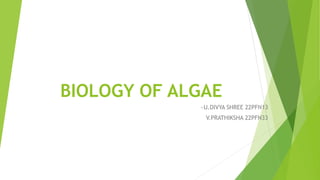
Algae.pptx
- 1. BIOLOGY OF ALGAE ~U.DIVYA SHREE 22PFN13 V.PRATHIKSHA 22PFN33
- 2. What is Algae? The term algae is from the Latin alga, meaning “seaweed”. Alga is a term that describes a large and incredibly diverse group of eukaryotic, photosynthetic lifeforms. These organisms do not share a common ancestor and hence, are not related to each other (polyphyletic).” Algae exist in environments ranging from oceans, rivers, and lakes to ponds, brackish waters and even snow. Algal cells are eukaryotic. Algae are usually green, but they can be found in a variety of different colours. For instance, algae living in snow contain carotenoid pigments in addition to chlorophyll, hence giving the surrounding snow a distinctive red hue.
- 3. Most algae require a moist or watery environment; hence, they are ubiquitous near or inside water bodies. Multicellular examples of algae include the giant kelp and brown algae. Unicellular examples include diatoms, Euglenophyta and Dinoflagellates. Anatomically, they are similar to another major group of photosynthetic organisms – the land plants but Algae lack many structural components typically present in plants, such as true stems, shoots, and leaves. Furthermore, they also do not have vascular tissues to circulate essential nutrients and water throughout their body.
- 5. Characteristics of Algae Algae can photosynthesize like plants, and they possess specialized structures and cell-organelles, like centrioles and flagella, found only in animals. Their cell walls consist of mannans, cellulose and Galatians. They are photosynthetic organisms Algae can be either unicellular or multicellular organisms They lack a well-defined body, so, structures like roots, stems or leaves are absent Algaes are found where there is adequate moisture. Reproduction in algae occurs in both asexual and sexual forms. Asexual reproduction occurs by spore formation. Tyey are free-living, although some can form a symbiotic relationship with other organisms.
- 6. Haemococcus pluvialis protects itself by accumulating astaxanthin in excessive bright light conditions.
- 7. Edible Algae
- 8. Types of Algae There are many types of algae. However, these are some of the more prominent types: Red Algae: Also called Rhodophyta, it is a distinctive species found in marine as well as freshwater ecosystems. The pigments phycocyanin and phycoerythrin are responsible for the characteristic red colouration of the algae. Other pigments that provide green colouration (such as chlorophyll a) are present. However, they lack chlorophyll b or beta-carotene.
- 9. Green Algae: It is a large, informal grouping of algae having the primary photosynthetic pigments chlorophyll a and b, along with auxiliary pigments such as xanthophylls and beta carotene. Higher organisms use green algae to conduct photosynthesis for them. Other species of green algae have a symbiotic relationship with other organisms. Members are unicellular, multicellular, colonial and flagellates. Prominent examples of green algae include Spirogyra, Ulothrix, Volvox, etc.
- 10. Blue-Green Algae: In the past, blue-green algae were one of the most well-known types of algae. However, since blue-green algae are prokaryotes, they are not currently included under algae (because all algae are classified as eukaryotic organisms). Also called cyanobacteria, these organisms live in moist or aquatic environments just like other algae. These include dams, rivers, reservoirs, creeks, lakes and oceans. This class of bacteria obtains energy through the process of photosynthesis. Ecologically, some species of blue-green algae are significant to the environment as it fixes the nitrogen in the soil. Hence, these are also called nitrogen-fixing bacteria. E.g. Nostoc, Anabaena, etc.
- 13. Examples of Algae Prominent examples of algae include: Ulothrix Fucus Porphyra Spirogyra Giant kelp Diatom Wakame Marimo Sea lettuce
- 14. Uses of Algae Recent developments in science and technology have enabled algae to be used as a source of fuel. Global demand for petroleum products and declining environmental health have prompted the use of eco-friendly alternatives such as algal biofuel. Hence, algae fuel is an increasingly viable alternative to traditional fossil fuels. It is used to produce everything from “green” diesel to “green” jet fuel. It is similar to the other biofuels made from corn and sugar cane. Commercial and industrial algae cultivation has numerous uses, including production of food ingredients such as omega-3 fatty acids or natural food colorants and dyes, food, fertilizer, bioplastics, chemical feedstock (raw material), pharmaceuticals, and algal fuel, and can also be used as a means of pollution control. It is used in preparation of nutrient agar , a microbial growth medium. <br> Algin extracted from brown algae is used in preparation of Ice creams , jellies and chocolates.
- 17. Q&A!
- 18. 1.What are Algae? Give examples n importance: Algae are defined as a group of predominantly aquatic, photosynthetic, and nucleus-bearing organisms that lack the true roots, stems, leaves, and specialized multicellular reproductive structures of plants. Few examples are: Ulothrix. Fucus. Porphyra. Spirogyra Importance:Algae form the primary source of food for many organisms in the food chain. From an economical perspective, algae are very useful for creating biomass or fertilizers as they grow very fast.
- 19. 2. How are algae different from traditional plants? Unlike traditional plants, algae do not have true roots, stems and leaves. Hence, they need to be near a moist or watery environment to survive. In other words, they do not possess vascular tissue necessary for the conduction of water and minerals.
- 20. 3. State the general characteristics of algae. Algae are either unicellular or multicellular in nature Found in moist places Mode of reproduction can be sexual as well as asexual They are photosynthetic in nature Are mostly free-living
- 21. 4.Are algae toxic to humans? Algae are generally harmless to humans. However, certain species of algae can form algal blooms, which can have detrimental effects on human health and the environment.
- 22. 5.How are algae useful? Algae are known to fix 50% carbon dioxide. Being photosynthetic, they increase the oxygen content of their environment. They are primary producers and many organisms derive food from them. Many commercial products are obtained from algae such as align, etc.
- 23. Thank you!